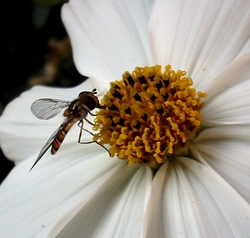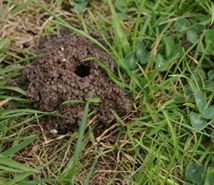
-
The Diptera (Flies, including Hoverflies) is a large order of insects.
-
The name means 'two-winged'. It is a reference to the fact that flies only have two wings, whereas bees and wasps have four wings.
-
The adults of a number of types of flies will drink nectar as well as taking other foods. Hoverflies in particular specialise in feeding from flowers.
-
Many Hoverflies mimic bees or wasps as protection from birds - they have stripy yellow and black patterns. In fact none of them can sting.
-
A major difference from bees and wasps is that hoverflies have free-living larvae, which live in a number of habitats. The larvae do not feed from flowers, and the parents do not supply the larvae with food.
-
Adult hoverflies may be important pollinators of wild flowers.
 |
|
 |
There are many different kinds of flies (Diptera), are large group of insects that includes the Hoverflies (Syrphidae). Typical Diptera mouthparts consist of a short fleshy tube which they use to suck up liquid or semi-liquid food. Some also ingest pollen.
As well as being pollinators of wild flowers, Diptera are also a food source for some insectivorous birds.
Diptera tend to visit small, flat flowers which present their nectar openly; many flowers of the Carrot or Umbellifer family (Apiaceae), are of this kind. The illustration on the left shows a Hoverfly visiting Fennel, a 'must-have' flower for any garden dedicated to pollinators.
Daisies (Asteraceae) that have very small florets in the central disc of each flower are also attractive to Hoverflies, as well as small solitary bees.
Although adult Hoverflies are mainly flower specialists, consuming nectar or pollen, Hoverfly larvae are mostly carnivorous. About 280 species of hoverflies have been recorded in Britain
The larvae are free-living and (unlike the larvae of bees and wasps) do not receive any form of parental food provision. The larvae of some Hoverfly species eat aphids.
The larvae of some other species, such the Drone Fly, are semi-aquatic and live in stagnant pools of water, where they consume bacteria. Some species of Hoverfly larvae live in rot holes or pools of water in old trees.
Last updated 1 September 2015. © Marc Carlton 2006 - 2015. See 'About this Website' for terms of use.


